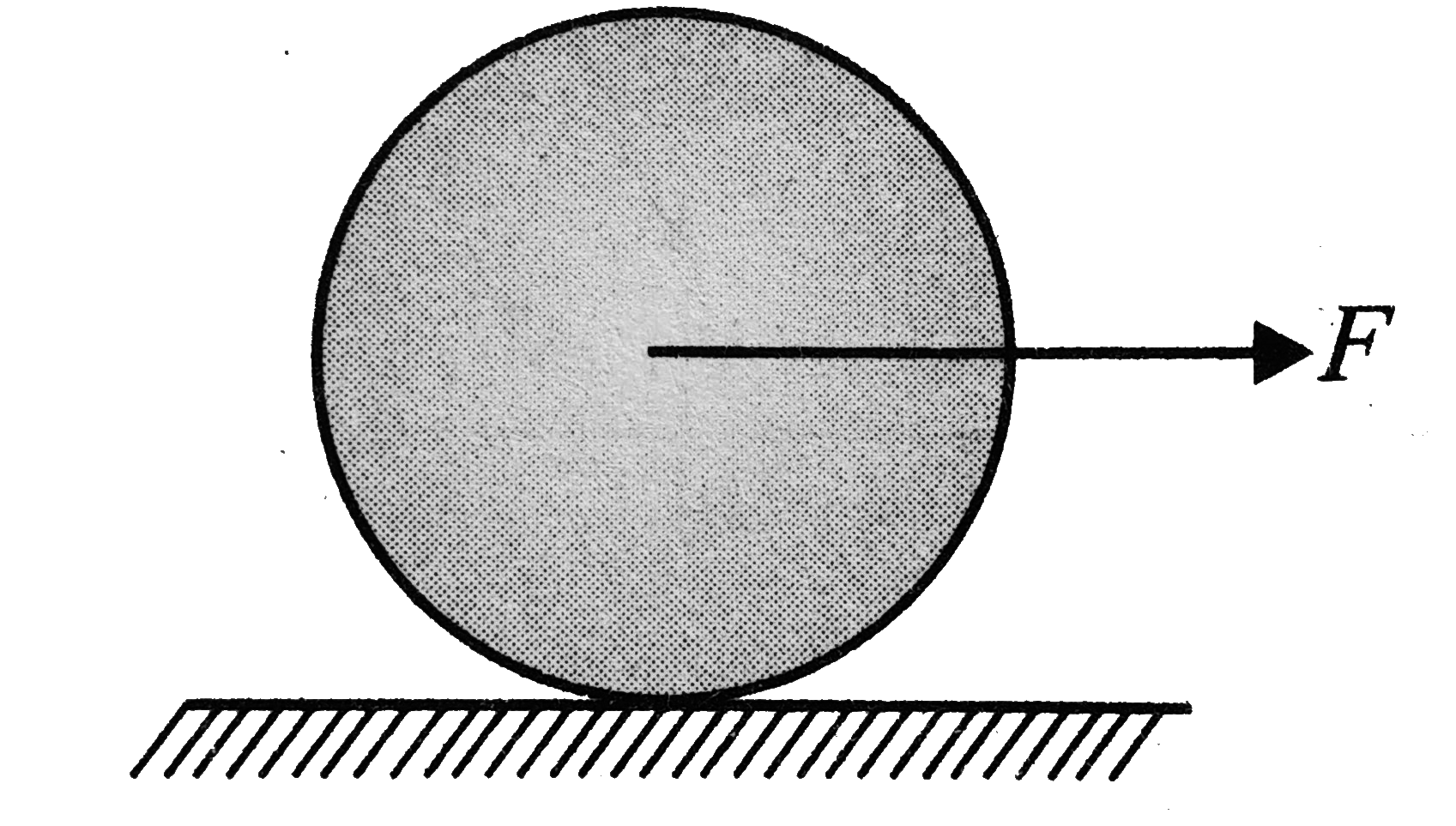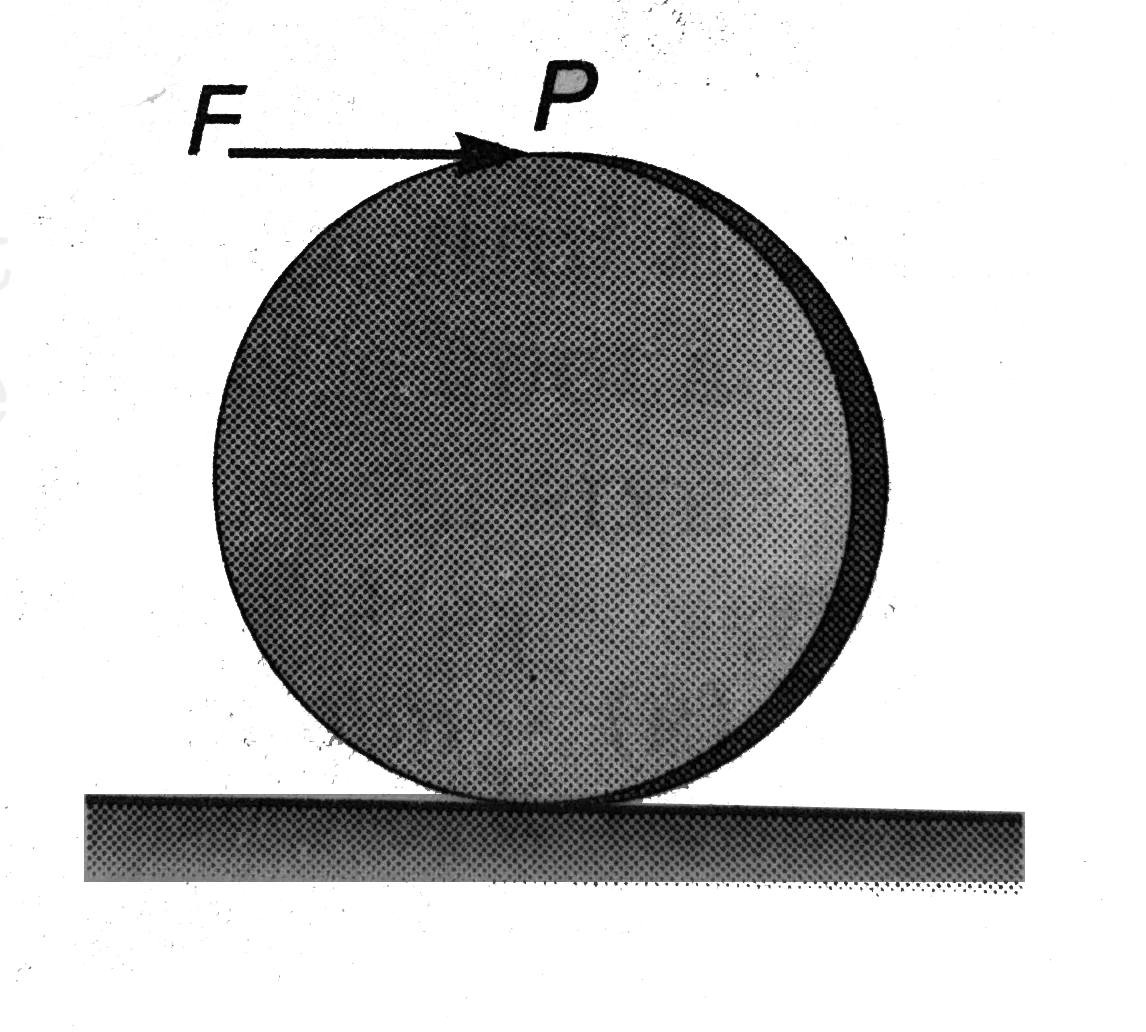A uniform ring of mass 'm' and radius 'R' is projected horizontally with velcoty on a rough horizontal floor, so that it starts off with a purely sliding motion and it acquires a pure rolling motion after moving a distance d. If the coefficient of friction between the ground and ring is , then work done by the friction in the process is
The correct Answer is:B
To find the work done by friction on a uniform ring of mass 'm' and radius 'R' projected horizontally with an initial velocity v0 on a rough horizontal floor, we can follow these steps:
Step 1: Understand the Initial Conditions
Initially, the ring is sliding with a velocity v0 and has no rotational motion. The initial kinetic energy (KE_initial) of the ring is given by:
KEinitial=12mv20
Step 2: Final Conditions for Pure Rolling
After traveling a distance d, the ring transitions to pure rolling motion. In pure rolling, the relationship between the translational velocity v and the angular velocity ω is:
v=Rω
Let the final translational velocity be v. The final kinetic energy (KE_final) when the ring is rolling is the sum of translational and rotational kinetic energy:
KEfinal=12mv2+12Iω2
For a ring, the moment of inertia I is:
I=mR2
Substituting ω=vR:
KEfinal=12mv2+12mR2(vR)2=12mv2+12mv2R2R2=12mv2+12mv2=mv2
Step 3: Conservation of Angular Momentum
We can use the conservation of angular momentum about the point of contact. The initial angular momentum Linitial is:
Linitial=mv0R
The final angular momentum Lfinal when rolling is:
Lfinal=mvR+Iω=mvR+mR2(vR)=mvR+mvR=2mvR
Setting them equal gives:
mv0R=2mvR
Cancelling mR from both sides (assuming R≠0):
v0=2v⇒v=v02
Step 4: Calculate the Work Done by Friction
The work done by friction W is equal to the change in kinetic energy:
W=KEfinal−KEinitial=mv2−12mv20
Substituting v=v02:
W=m(v02)2−12mv20=mv204−12mv20
W=mv204−2mv204=−mv204
Final Answer
Thus, the work done by friction is:
W=−14mv20
Initially, the ring is sliding with a velocity v0 and has no rotational motion. The initial kinetic energy (KE_initial) of the ring is given by:
KEinitial=12mv20
After traveling a distance d, the ring transitions to pure rolling motion. In pure rolling, the relationship between the translational velocity v and the angular velocity ω is:
v=Rω
Let the final translational velocity be v. The final kinetic energy (KE_final) when the ring is rolling is the sum of translational and rotational kinetic energy:
KEfinal=12mv2+12Iω2
For a ring, the moment of inertia I is:
I=mR2
Substituting ω=vR:
KEfinal=12mv2+12mR2(vR)2=12mv2+12mv2R2R2=12mv2+12mv2=mv2
We can use the conservation of angular momentum about the point of contact. The initial angular momentum Linitial is:
Linitial=mv0R
The final angular momentum Lfinal when rolling is:
Lfinal=mvR+Iω=mvR+mR2(vR)=mvR+mvR=2mvR
Setting them equal gives:
mv0R=2mvR
Cancelling mR from both sides (assuming R≠0):
v0=2v⇒v=v02
The work done by friction W is equal to the change in kinetic energy:
W=KEfinal−KEinitial=mv2−12mv20
Substituting v=v02:
W=m(v02)2−12mv20=mv204−12mv20
W=mv204−2mv204=−mv204
Thus, the work done by friction is:
W=−14mv20
Similar Questions
A uniform disc of mass m and radius R is projected horizontally with velocity v0 on a rough horizontal floor so that it starts off with a purely sliding motion at t=0. After t0 seconds, it acquires pure rolling motion as shown in the figure.
(a) Calculate the velocity of the center of mass of the disc at t0.
Assuming that the coefficent of friction to be μ, calculate t0.

View SolutionA block of mass 50 kg slides over a horizontal distance of 1m. If the coefficient of friction between their surface is 0.2, then work done against friction is (take g=9.8m/s2) :
View Solution
Knowledge Check
A vehicle of mass M is moving on a rough horizontal road with a momentum P If the coefficient of friction between the tyres and the road is μ is then the stopping distance is .
Ap2μmgBp22μmgCp2μm2gDp22μm2g
A hollow sphere of mass m and radius R is rolling downdard on a rough inclined plane of inclination θ. If the coefficient of friction between the hollow sphere and incline is μ, then
View SolutionA block of mass m is moving on a rough horizontal surface. μ is the coefficient of kinetic friction between the block and the surface. What is the net force exerted by the surface on the block?
View SolutionA vehicle of mass m is moving on a rough horizontal road with kinetic energy 'E'. If the co-efficient of friction between the tyres and the road be μ. Then the stopping distance is,
View SolutionA solid sphere of mass m is lying at rest on a rough horizontal surface. The coefficient of friction between the ground and sphere is μ. The maximum value of F, so that the sphere will not slip, is equal to

View Solution
A uniform solid cylinder of mass m and radius R is placed on a rough horizontal surface. A horizontal constant force F is applied at the top point P of the cylinder so that it start pure rolling. The acceleration of the cylinder is
View SolutionA block of mass m is moving with a constant acceleration a on a rough horizontal plane. If the coefficient of friction between the block and ground is μ, the power delivered by the external agent in a time interval t from the beginning is equal to:
View SolutionA horizontal force F pulls a 20 kg box at a constant speed along a rough horizotal floor. The coefficient of friction between the box and the floor is 0.25. The work done by force F on the block in displacing it by 2 m is
View Solution
